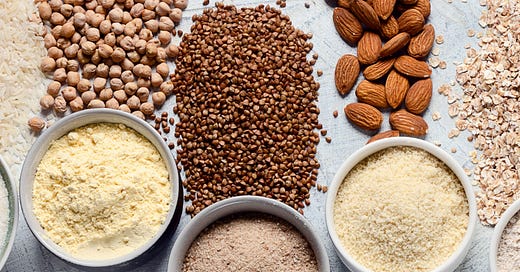Swaps #4 - Gluten free flour guide
I get flooded with questions about gluten-free flours. It can get so confusing with all of the information out there- which gluten-free flour is the best? Can I just substitute any gluten-free flour?
Gluten-free does not automatically equal healthy.
I’ve compiled a list of a few of my favorite gluten-free flours and shared how to use these flours so you can feel like a pro in the kitchen.
What is Gluten?
Gluten is a family of proteins commonly found in wheat and rye products. It is typically used as a ‘glue’ to bind and hold the shape.
Because products containing gluten are usually refined or processed, overconsumption of processed flours can be associated with inflammation and blood sugar dysregulation.
Should everyone avoid gluten?
No - I do not believe so. We are all different and some people can tolerate gluten without any trouble. A lot of the sequela we see from gluten may be a) it tends to be processed b) wheat is a highly sprayed crop and so the pesticides may be causing gut issues rather than gluten itself.
About 1% of the population suffers from Celiac Disease, an autoimmune disease where gluten consumption severely damages the small intestine. The diagnosis is usually made on biopsy via an endoscopy where destruction of the intestinal structure can be seen.
While Celiac is a serious condition requiring absolute abstinence from gluten, more and more people are starting to struggle with gluten sensitivity.
Non-Celiac Gluten sensitivity is a clinical syndrome characterized by intestinal and extra-intestinal (outside of the gut) symptoms that go away with gluten exclusion, and re-appear on gluten introduction. There is yet no reliable test and so diagnosis is usually via clinical history in the hands of an experienced clinician, with an elimination/reintroduction. Symptoms may include brain fog, migraines, skin issues, bloating, diarrhea.
So, for those of us who cannot tolerate gluten - what are some of the options?
Gluten-Free Baking Basics
While there is plenty of cup-for-cup gluten-free flour blends on the market, I like making my own blend so I have more control on what goes into it.
When it comes to premade flour blends, they often include a lot more ingredients than just flour. They can contain preservatives and additives that provide structural aspects similar to using regular all-purpose flour. It is absolutely fine to use these once in a while, but I don't want to use them regularly.
In need of inspiration? Check out my recipe e-books, all my recipes are gluten-free.
8 gluten-free flours that I use at home.
Read on to find out which one is my favorite!
Manioc / Cassava Flour
Cassava flour is the closest consistency to regular flour that you will find. It is made from the cassava root and is soft and light, as well as neutral in flavor and texture. (food matters), and can be subbed in recipes in place of wheat flour.
As a plus, it is nut-free and provides dietary fiber - in particular, resistant starch, which is a prebiotic that helps to feed your gut microbiome, and has been found to help improve insulin sensitivity.






